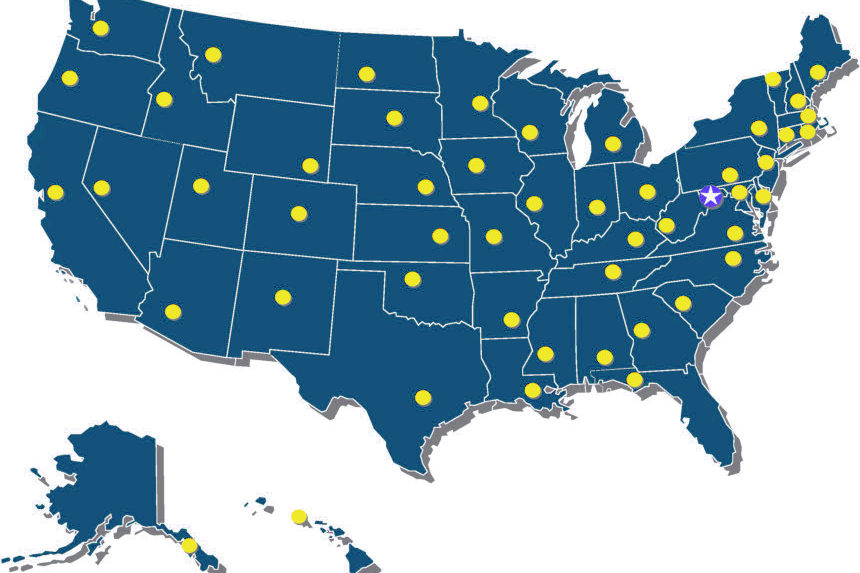This is the third and last part of a series exploring the histories of the names of all 50 state capitals. They are listed alphabetically by state name, so to find out about the capitals of Alabama through Kansas, read Part I — Montgomery to Topeka; for the capitals of Kentucky through North Carolina, read Part II — Frankfort to Raleigh.
For the last third of our state capitals — from Bismarck, North Dakota, to Cheyenne, Wyoming — read on:
Bismarck, North Dakota
The growth of Bismarck is linked with the arrival of the Northern Pacific Railway, which reached the Missouri River in North Dakota in 1872. They created a terminus, called Burleigh Town, about two miles south of present-day Bismarck. On May 14 of that year, the town of Edwinton — in honor of Edwin Ferry Johnson, a Northern Pacific Railway civil engineer from Vermont — was staked out and christened.
The railroad at this time was having some funding difficulties in its transcontinental program. In an attempt to attract German investors, Edwinton was renamed Bismarck on July 17, 1873, after Otto Eduard Leopold von Bismarck-Schönhausen, the Prussian statesman who was a key figure in the unification of Germany and who had become its first chancellor in 1871.
The surname Bismarck is said to be a shortening of Biscofsmark, meaning “bishop’s boundary.” And although Otto himself didn’t invest in the railroad, he did send a nice thank-you note.
Columbus, Ohio
Yes, the capital of Ohio was, like Columbia, South Carolina (below), named after Christopher Columbus. The new state’s government had spent short periods in Chillicothe and Zanesville, but ultimately a more centrally located capital was desired. In 1812, state legislators decided on the location of Columbus — which didn’t even exist until that point — not only because it was closer to the center of the state but because its proximity to the Scioto and Olentangy Rivers made it a good hub for transportation and shipping. The city was laid out that year and construction began; the government moved into the city in 1816.
Christopher Columbus’s name — Cristoforo Colombo in the original Italian — literally means “Christ-carrying dove,” from the Latin phoros “bearer” and columba “dove.”
Oklahoma City, Oklahoma
As I explained in “The Surprising Story Behind Every State’s Name,” Choctaw chief and Presbyterian minister Allen Wright is credited with coining Oklahoma in 1866 by combining two Choctaw words into a new one meaning “Land of the Red People.” In the 1880s, the Southern Kansas Railway made its way through this new territory, and a train stop called Oklahoma Station was establish in 1887. During the Land Run of 1889, an estimated 4,000-6,000 settlers poured into the Oklahoma Station area in late April to lay claim to the town lots. The city essentially sprang into existence overnight, though it wouldn’t officially be called Oklahoma City until July 1, 1923.
Salem, Oregon
In 1841, Methodist missionaries established a mission in Oregon’s Willamette Valley near a Kalapuya village called Tchimikiti, which means “place of rest.” The village that grew up around the mission was for a while called Chemeketa, based on the Kalapuya name.
In 1846, when William Willson officially founded a new city in its place, he kept the idea of the Kalapuyan place name but gave it a Western bent with a biblical origin: Salem means “peace” (from the Hebrew shalom) and is a place name mentioned in Genesis. (You might notice that salem is also the last half of Jerusalem — that name means “foundation of peace.”)
Salem became the capital of the Oregon Territory in 1851 and stayed the capital when Oregon achieved statehood in 1859.
Harrisburg, Pennsylvania
John Harris, an Englishman who accompanied William Penn into present-day Pennsylvania, built a log cabin for himself and his wife Esther on the banks of the Susquehanna River around 1719. Until his death in 1748, Harris farmed, established numerous trading posts, and built the first ferry across the Susquehanna — which would play a significant role during the Revolutionary War. The area became known as Harris’s Ferry.
Around 1727, Esther gave birth to a boy whom they named John Harris Jr. It was the younger Harris who would establish the state’s capital. His son-in-law laid out the city in 1785, at first calling it Louisbourg, to honor of the aid France’s King Louis XVI gave during the Revolution. (Harrisburg is in Dauphin County, which was named in honor of King Louis’ son.) But Harrisburg was the name used on the city charter in 1791, after the family whose log cabin began it all.
The name Harris comes from Harry, which is a familiar version of Henry. Henry, in turn, traces back through French, Late Latin, German, and finally Old High German to Heimerich, literally “ruler of the house.” Burg is simply an Old English word indicating an enclosed village.
Providence, Rhode Island
After fleeing religious persecution in Massachusetts, preacher Roger Williams bought land from the Narragansett tribe and established a new settlement with the promise of true religious and political freedom. He called it Providence in thanks to God for protecting him in Massachusetts.
Providence comes from the Latin pro- “ahead” + videre “to see”; providentia meant “foresight.” Since the 14th century, the phrase divine providence indicated “God’s guidance and guardianship,” and over time, Providence alone was used to refer to God and His beneficence.
Columbia, South Carolina
Quite a number of towns and cities in the United States — including one other state capital — were named, in one way or another, after Christopher Columbus, but Columbia, South Carolina, was the first. (The name Columbia beat out the next-most-popular option, Washington.)
The site of a former frontier fort, the location was chosen to be the new state capital in 1786, and planners laid out the area in a grid of streets and lots along the Broad River, making it North Carolina’s first planned city, and the nation’s second (after Savannah, Georgia).
Pierre, South Dakota
Fur trappers and traders established a settlement and trading post on the Missouri River in 1817, but the place wasn’t given an official name. That just wouldn’t do when, in 1880, the Chicago and North Western Railroad chose the location as its new western terminus.
The name Pierre was chosen in honor of Pierre Chouteau Jr., a successful early-century fur trader who, in 1830, became the first man to take a steamboat up the Missouri River. Pierre, like Peter, comes from the Greek petros “rock, stone.”
Pierre was voted as a temporary state capital when South Dakota became a state in 1889; subsequent elections in later years established it as the state’s permanent capital.
Nashville, Tennessee
In 1779, James Robertson and John Donelson built a stockade surrounding two acres of land. Naming it after Gen. Francis Nash, a North Carolinian hero of the Revolutionary War who died at the Battle of Germantown, they called their new settlement … Fort Nashborough.
It was aptly named, too: borough traces back to the Old English burg “dwellings within a fortified structure,” which is exactly what Fort Nashborough was. But that wasn’t good enough for some people: The –borough was replaced with -ville — from the Latin villa “country house” — in 1784.
The fort itself was abandoned in 1794, but the settlement flourished, becoming the capital of Tennessee when it became a state in 1796.
The surname name Nash, which is recorded back to the 13th century, indicates either “near an ash tree” or “near a place called Ash.”
Austin, Texas
American culture has a number of Steve Austins to its credit. Fans of 1970s science fiction know Steve Austin as the title character of The Six Million Dollar Man, played by Lee Majors. Professional wrestling fans, however, will go straight for the bald, buff superstar “Stone Cold” Steve Austin.
But before either of these Steve Austins, there was Stephen F. Austin. Considered the “Father of Texas,” Stephen F. brought 300 families (and their enslaved servants) to the area in 1825, the second settlement attempt and the first successful one. He was a key figure in Texas winning its independence from Mexico.
Incidentally, “Stone Cold” Steve Austin’s given name is Steven Anderson, and he was born in Austin, Texas. His nom de guerre is no coincidence.
Salt Lake City, Utah
There isn’t much surprising about how Salt Lake City got its name. When Brigham Young and the Mormon emigrants he led broke ground on their new home on July 24, 1847, they named the location after the most prominent nearby geological feature, the Great Salt Lake. They used the full name back then though, calling the settlement Great Salt Lake City; the Great was dropped from the name in 1868, and SLC became the state capital when Utah achieved statehood in 1896.
Montpelier, Vermont
In 1781, Joel Frizzel and Jacob Davis — a war veteran — received a charter from Vermont to build a town. By 1787, Davis had built a log cabin there and he, Frizzel, and other associates spent two years clearing a large area for settlement, which they named Montpelier.
The Mont is the same “hill, mountain” found in the state’s name. The -pelier evolved from the Latin pastellus “woad,” an herb used to make blue dye. So was there some significant geological structure pointing toward a “blue-dye mountain” in the “green mountain” state?
No. It was named after Montpellier, France, a popular retreat near the Mediterranean. (Notice that the French but not the American version has a double-l.) After the Revolutionary War ended, there was a certain fervor for the French in the newly independent states because of the aid that King Louis XVI had given in the fight against the British, and many French place names found themselves attached to American towns and cities. (See also Harrisburg, Pennsylvania.)
And as for the name, the Concise Oxford Dictionary of World Place Names states that the name originally meant “little pile of stones.” Little is right: Montpelier is the country’s least populous state capital.
Richmond, Virginia
In 1733, four years before the town would be laid out, William Byrd of Westover named the settlement along the James River Richmond after the city of Richmond upon Thames, England — another New World settlement named after an Old World town. Strangely, the English Richmond was not Byrd’s birthplace: William Byrd was born in the colonies on his father’s plantation on the James River, though he spent most of his youth and adolescence in England.
The name Richmond comes from an Anglicization of the French Richemont (riche “rich” + mont “hill”) and is the equivalent of “rich mound.”
Olympia, Washington
On July 4, 1788, a British captain named John Meares sighted the snow-capped mountains of Washington. The tallest one reminded him of Mount Olympus, from Greek mythology, and so he called it that.
His choice of Greek mythology might have been influenced by the knowledge that, 200 years earlier, Juan de Fuca had traveled through and explored the area in his search for the Northwest Passage. Juan de Fuca — whose given name was Ioannis Phokas — was Greek, but his journeys were in the service of King Philip II of Spain, which is why he is more well-known by his Hispanicized name. Today, the stretch of water between Vancouver Island and northwestern Washington State is called the Strait of Juan de Fuca.
The group of mountains of which Mount Olympus (Washington) was the tallest came to be called both the Olympus Mountains and the Olympic Mountains, the latter eventually winning out. Originally established as Smithfield, Olympia was rechristened in 1850, after those mountains.
Charleston, West Virginia
Like the much larger city of the same name in South Carolina, Charleston, West Virginia, was originally founded as Charles Town. However, West Virginia’s future capital was not named after England’s King Charles II. Instead, it was named for the father of Col. George Clendenin, who established Fort Lee in 1788, the anchor around which the city, which was chartered in 1794, would grow.
The name Charles — Carlos in Spanish and Portuguese, Karol in Polish and Slovak, Carolus in Latin — traces back to the German Karl, which simply means “man” or “husband.”
Madison, Wisconsin
The Wisconsin Territory was incorporated into the United States in 1836, and a large amount of land speculation proceeded quickly thereafter. A former federal district judge named James Duane Doty got his hands on some huge tracts of land, on which he founded a new city and named it after President James Madison, who had died that summer. In the same year, he persuaded legislators to make his new city the capital, and construction of the capitol building began even while most of the land was still uninhabited (at least by westerners).
Like most surnames that end this way, the -son in Madison is literal — in this case probably a variation on Mathieson “son of Matthew.”
Cheyenne, Wyoming
Born in Massachusetts in 1831, Grenville Dodge was on his way to becoming a successful civil engineer when the Civil War broke out. Dodge joined the Union forces and served admirably, reaching the rank of major general and ending the war in command of the District of the Mississippi. After Appomattox, he gave up his military career and returned to the railroad business, becoming the lead engineer for the Union Pacific Railroad. In 1867, that railroad came through what would one day be the capital of Wyoming, and Dodge himself surveyed the town.
As you probably guessed, it was named Cheyenne after the Algonquian tribe of the area. The word Cheyenne is the French Canadian transliteration of the Dakota word Sahi’yena, what the Dakotans called the Cree. Sahi’yena is a diminutive of Sahi’ya, which means “unintelligible speakers” but literally translates to “red speech.”
Become a Saturday Evening Post member and enjoy unlimited access. Subscribe now



